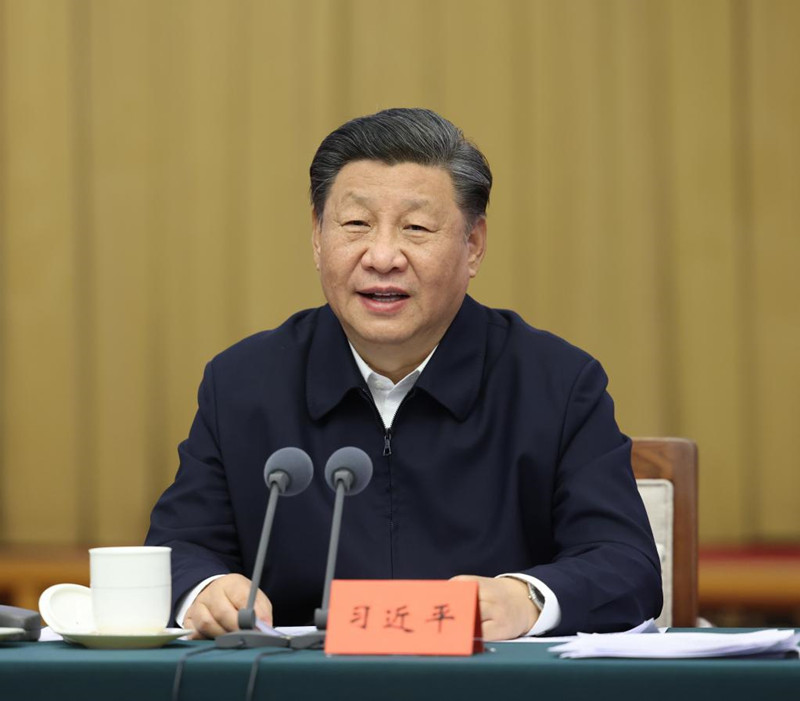Great strides being made in protecting Yellow River

President Xi Jinping, also general secretary of the Communist Party of China Central Committee and chairman of the Central Military Commission, chairs a symposium on ecological protection and high-quality development of the Yellow River basin in Jinan, East China's Shandong province, Oct 22, 2021. [Photo/Xinhua]
The stepped-up protection of the Yellow River, also known as China's "Mother River" and the cradle of Chinese civilization, has once again exemplified the nation's unremitting efforts to improve its ecological environment and the livelihoods of people depending on it.
That endeavor came into the spotlight as President Xi Jinping wrapped up his inspection tour in October of the downstream part of the river, with a symposium dedicated to it.
Throughout the three-day trip in eastern Shandong province, Xi, who is also general secretary of the Communist Party of China Central Committee and chairman of the Central Military Commission, stressed the importance of ecological protection of the Yellow River basin, again highlighting his vision for ecological civilization in the country.
Since the 18th National Congress of the CPC in 2012, Xi has made many instructions on matters related to the Yellow River. After his visit to Dongying, Shandong province, Xi had made inspections of the river's upper, middle and lower streams.
In the symposium, Xi asked to make protection "the key task" in the Yellow River basin, underlining the priority he has consistently put on ecological civilization. "We should protect the environment like we protect our eyes and treat the environment like we treat our lives," he said.
The Yellow River is an example of Xi's persistent emphasis on promoting ecological civilization-a concept promoted by Xi for balanced and sustainable development that features the harmonious coexistence of man and nature.
Originating in Qinghai province, the 5,464-kilometer Yellow River, the second-longest river in China, runs through nine provincial regions: Qinghai, Sichuan, Gansu, Shanxi, Shaanxi, Henan and Shandong provinces and the Ningxia Hui and Inner Mongolia autonomous regions.
The Yellow River basin is an important ecological barrier and is strategically significant for China's national development and modernization.
The scope of the planning covers county-level administrative regions through which the main tributaries of the river flow, with a land area of about 1.3 million square km and a population of about 160 million as of the end of 2019.
Since 1998, China has piloted a nationwide natural forest protection project in 12 provincial areas. The project was later expanded to cover eight provincial areas through which the Yellow River runs.
Compared with the fifth national forestry resources survey, for 1994-98, the forest area along the Yellow River had increased by 6.43 million hectares in the ninth survey, for 2014-18.
During the period, forest stock volume-the total volume of the stems of all living trees per unit area, which is often used for forest resource management and planning and as a predictor of carbon-related variables and carbon stocks-increased by 329 million metric tons along the river.
As regions along the Yellow River became greener, the environment of nearby areas and the water quality of the river have improved.
In Qinghai, where the sources of the Yangtze, Yellow and Lancang rivers are found, the water amount of the three rivers has soared, with an additional 8.4 billion tons recorded from 2010 to 2020, according to the National Forestry and Grassland Administration.
During that same period, the area of wetland in the river source region increased by 104 square km, according to the administration.
Statistics from the administration also showed that the Yellow River has become gradually clearer, with dwindling sediment concentrations.
At the Huayuankou observation center in Henan, sediment concentrations in the river had dropped from 26.4 kilograms per square meter in 2000 to 22.4 kg in 2018.
During his visit to Shandong, Xi called for notable progress in ecological protection and high-quality development of the Yellow River basin during the 14th Five-Year Plan (2021-25) period.
Despite new progress, there are still major problems and difficulties facing ecological conservation and high-quality development of the basin, Xi said.
Better work should be done to control soil erosion and desertification in the upper and middle reaches of the Yellow River, and to strengthen coordinated environmental overhaul of the lower reaches' waterways and flood plain, Xi said, adding that biodiversity in the river delta should be enhanced.
In October, the CPC Central Committee and the State Council jointly issued a document outlining the ecological protection and high-quality development of the Yellow River basin to further protect the "Mother River".
The document will guide the country's ecological conservation and high-quality development of the Yellow River basin through 2030 and beyond, and serve as an important basis for formulating and implementing relevant planning programs, policies and measures, as well as building engineering projects.
In October, Lu Hao, vice-minister of natural resources, submitted a report on management of State-owned natural resources to the National People's Congress Standing Committee.
In the report, Lu said that great achievements on natural resource protection and management have been made over the past five years, as the ministry enumerated several new policies on the protection of nature reserves and water resources.
"The ministry is speeding up the establishment of a national territory spatial plan (2021-35) based on the survey to improve the quality of the country's ecosystems," Lu said.
- Top legislature schedules session for December
- China's top legislator holds talks with president of Luxembourg parliament
- China's top legislator meets with French president
- China, Maldives pledge to enhance exchanges between legislative bodies
- Senior Chinese legislator meets Portugal's PSD delegation



